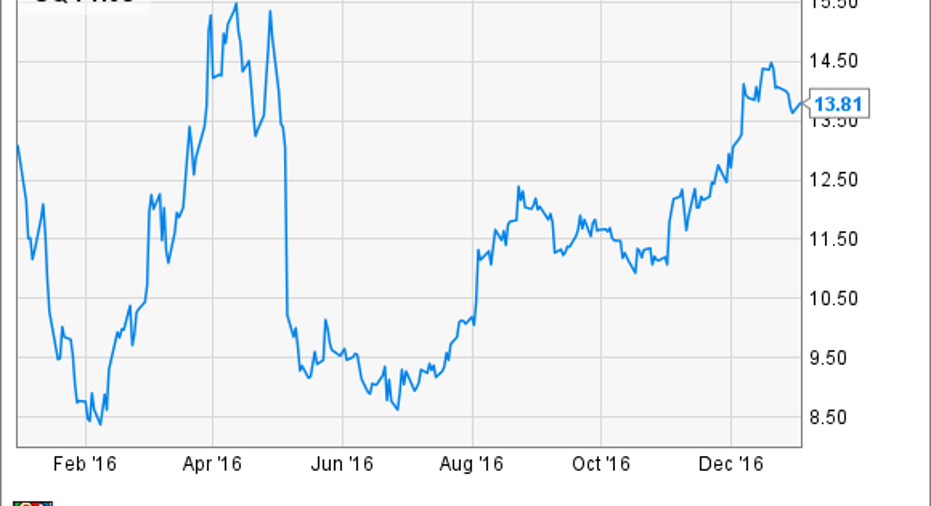3 Concerns for Square Inc Investors in 2017

Square Inc(NYSE: SQ) investors had a wild ride in 2016. Last January, the company's stock opened at $12.75; in June, shares regularly traded under $9. But they recovered to highs near $14 in the final trading days of the year:
More important for long-term investors than the daily fluctuations of the stock market, however, are a business's fundamentals. Fortunately for Square investors, there are plenty of encouraging signs. While the company is not yet profitable on a GAAP (generally accepted accounting principles) basis, other metrics show consistent growth across the company's many platforms. In Square's 2016 third quarter, the company reported $178 million in adjusted revenue, a 51% increase year over year. The company's gross payment volume (GPV) was $13.2 billion, a 39% increase year over year. If Square can continue these trends, 2017 could be another winning year for the company's investors.
This doesn't mean there aren't clouds on the horizon, though. Besides a lofty valuation for a company not yet making a profit (approximately 112 times trailing free cash flow), here are three potential causes for concern by Square investors in 2017.
Chasing bigger businesses through lower margins
Square was founded upon the principle that small businesses were underserved by traditional payment service providers. Even Square's annual 10-K filing with the SEC states, "We are driven by economic empowerment and work to democratize commerce -- leveling the playing field for sellers of all sizes." To its credit, the company has found a growing niche serving this long-neglected market.
There are many reasons for Square to pursue bigger business customers as well. First, these businesses will generally be more stable, providing steadier streams of revenue. Almost as important, signing up larger businesses for its payment-provider services gives Square the chance to upsell more lucrative services such as small loans, human resources, and data analytics.
Image source: Square Inc.
Square needs to be careful, though, that it doesn't hurt itself with smaller margins on transactions and the higher costs associated with courting larger businesses. Square currently charges its smaller business clients (defined as companies with revenue less than $250,000 per year) 2.75% per swipe for credit and debit cards. Of that amount, the credit card companies take about 0.15% and the issuing bank about 2%. This leaves Square with just 0.6% from each transaction.
In the pursuit of larger businesses, Square has clearly signaled it is not afraid to compete on pricing. On the company's home page, prospective client businesses making under $250,000 per year are immediately shown the 2.75% fee per swipe. But potential customers making more than that are told to contact Square for "custom pricing packages." Again, it is good for Square to pursue larger businesses, but only if it doesn't kill itself on the margins doing so.
Offering Square Capital to non-Square customers
Square Capital, by which the company offers loans to its business customers, is one of Square's most successful platforms. Merchants then repay the loans by paying a higher percentage of the card swipes they process back to Square. In the company's most recently reported quarter, Square processed over 35,000 loans totaling more than $200 million, approximately a 70% year-over-year increase.
Because Square is so intimately familiar with its customers' businesses, it can choose who to offer these loans to with a high degree of discretion. Thus far it's working, as the company has maintained an amazing 4% loan loss rate for every single quarter in 2016. That's less than half the national default rate across all small businesses last year, according to WAIN Street's Business Default Index.
But if Square started offering loans to businesses outside of its payments ecosystem -- businesses from which Square has no payments data -- that loan loss rate would almost surely climb. Yet this is exactly what Square management hinted it might do in the company's 2016 second-quarter conference call. When asked this very question, CFO Sarah Friar responded:
Does Square have CEO Jack Dorsey's undivided attention?
This last point won't bother some readers as much as others, but the situation should be known by all potential investors in the company. Jack Dorsey is currently the chief executive officer of two multibillion-dollar tech companies: Square and Twitter.
In 2008, Dorsey was relieved of his duties as the CEO of Twitter but stayed on as chairman of the board. In 2010, Dorsey released Square's first mobile reader device. In 2015, Dorsey returned to Twitter as the CEO. He has since led both companies.
While I am obviously not privy to Dorsey's schedule, it is unclear how he splits his time between the companies. Suffice it to say, no one has ever questioned whether Mark Zuckerberg's or Jeff Bezos' attention is distracted from the giant tech companies they founded and still lead. How much this is perceived as a potential negative will probably depend upon the investor, but it's always best to know all the facts before making an investing decision.
10 stocks we like better than Square When investing geniuses David and Tom Gardner have a stock tip, it can pay to listen. After all, the newsletter they have run for over a decade, Motley Fool Stock Advisor, has tripled the market.*
David and Tom just revealed what they believe are the 10 best stocks for investors to buy right now and Square wasn't one of them! That's right -- they think these 10 stocks are even better buys.
Click here to learn about these picks!
*Stock Advisor returns as of January 4, 2017
Matthew Cochrane has no position in any stocks mentioned. The Motley Fool owns shares of and recommends Twitter. The Motley Fool has a disclosure policy.



















